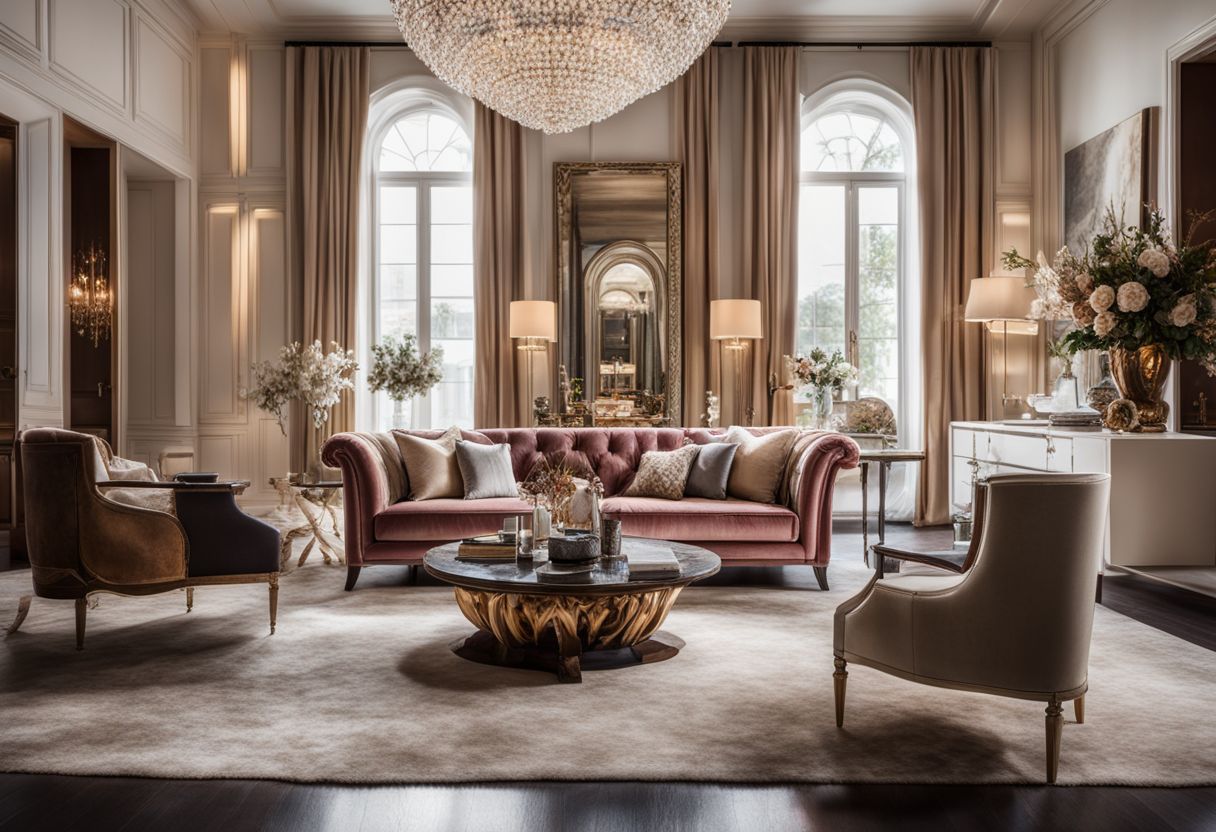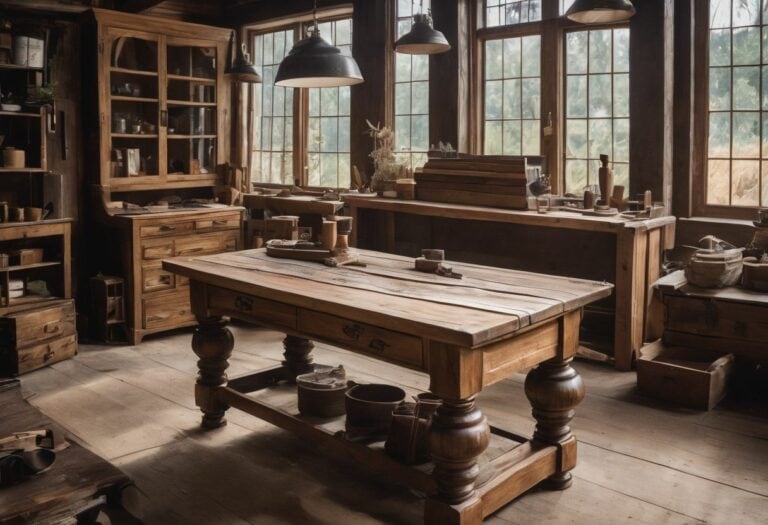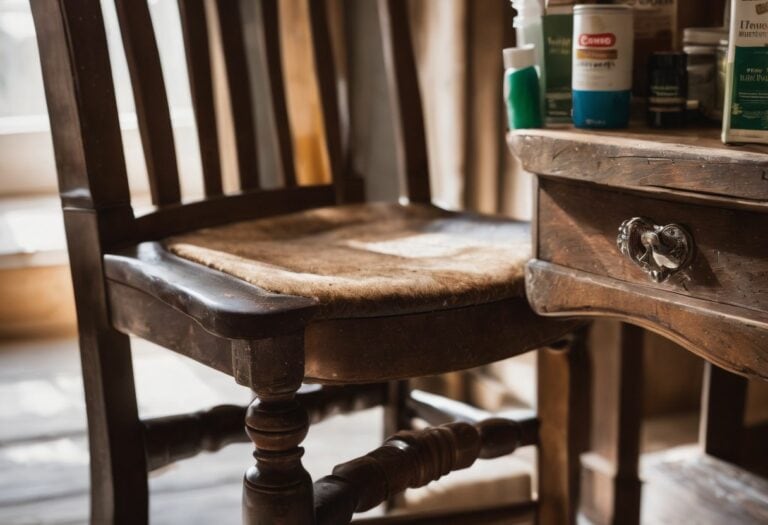Unraveling the Mystery: Why Is Home Decor So Expensive?
Stepping into a home decor store can feel like an adventure, until you catch sight of those pesky price tags. I’ve shared in the collective gasp too, and it seems we’re not alone – recent data shows that the cost of furnishings has seen a significant 7.6 percent hike.
This article is all set to pull back the curtain on why home decor often carries such a hefty cost and will share practical tips on how to maintain your sense of style without losing quality or burning a hole in your wallet.
So get cozy! We’re about to embark on an enlightening journey that just might revolutionize your decorating approach forever.
Key Takeaways
- Home decor can be expensive due to factors such as design complexity, furniture quality, and delivery fees.
- Using high – quality materials and incorporating unique design elements can create an expensive look in your home.
- The high cost of home decor is influenced by the quality of materials used and labor and production costs.
- When decorating your home, it’s important to prioritize spending on key areas like living rooms, kitchens, and bedrooms.
The Real Cost of Decorating and Furnishing Your Home

Decorating and furnishing your home can come with a hefty price tag, with the average cost of furnishing a home varying depending on factors such as room size, layout, and furniture quality.
Average cost of furnishing a home
Fixing up a home can be costly. It could cost between $10,000 and $60,000 in 2023. This is the national average cost to furnish a house. Sometimes, it might be even less than $3,500.
But most of the time, it’s near or around $16,000 based on Home Advisor’s estimate. The price range depends on what you want to buy for your house.
Factors that affect the cost
Decorating and furnishing a home comes with a price tag. A few things can affect this cost.
- Design complexity: The more complex the design, the higher the cost.
- Space size and setup: Large or oddly shaped rooms may need more decor.
- Furniture quality: Better quality usually means a higher price.
- Delivery fees: Getting your things to your home may cost extra.
- Type of wood used: Some woods are more costly than others.
- Furniture design aspects: Unique designs can add to the price.
- Furniture size: Bigger pieces often come with bigger prices.
- Craftsmanship and furniture durability: Well-made furniture tends to be pricier but lasts longer.
- Warranty terms for custom furniture: If it has good warranty terms, it might be more costly.
- Financial planning for home decoration expenses: You need to budget carefully for all these factors.
Making a Home Look Expensive

Using high-quality materials and incorporating unique design elements are key factors in creating an expensive look for your home.
The role of materials and design in creating an expensive look
In every home, materials and design set the feel. They give a room its rich texture and high-end aesthetic. Using fine woods, marble, or sustainable materials can ramp up the luxury factor in a heartbeat.
Linen and cotton are simple but can look quite classy when used well.
Design is just as key for that expensive look. Sleek lines and premium finishes add to an upscale decor. Mixing modern pieces with antique finds often leads to a unique style. Prints, patterns, bold colors also help if done right! They all craft an opulent atmosphere that seems exclusive.
Factors that Contribute to the High Cost of Home Decor
The high cost of home decor is influenced by factors such as the quality of materials used and the labor and production costs involved. Find out more about these factors and how they impact your budget in furnishing your dream home.
Quality of materials
When it comes to the high cost of home decor, one significant factor is the quality of materials used. The price of home decor items often reflects the value and durability of the materials they are made from.
Higher-end and premium pieces usually use exclusive materials that are known for their durability and luxurious feel. Craftsmanship also plays a role in the cost as skilled artisans put time and effort into creating each item with meticulous attention to detail.
Quality control ensures that these items meet consumer expectations and maintain their value over time. By prioritizing quality over a lower price, you can make more sustainable choices when it comes to decorating your home.
Labor and production costs
Labor and production costs are major factors that contribute to the high cost of home decor. Skilled labor is needed for manufacturing furniture, especially for specialized items like patio furniture.
This requires companies to invest in expensive machinery and pay a skilled workforce, which drives up the overall cost. Similarly, labor conditions play a significant role in the cost of construction for single-family homes.
Multinational corporations operating in multiple countries also face high relative costs as they adjust their products and practices to each market. All these expenses add up and impact the final price consumers have to pay for home decor items.
Where to Splurge and Save
When it comes to decorating your home, it’s important to know where you can splurge and where you can save. Find out which areas are worth investing in and discover money-saving tips for creating a stylish space without breaking the bank.
Interested? Keep reading!
Areas to prioritize spending on
Investing in quality furniture and durable materials is crucial.
Ways to save money while decorating
When it comes to decorating your home, there are some smart ways to save money. Here are a few tips that can help:
- Look for sales and discounts: Keep an eye out for sales at furniture stores or online retailers. You might be able to score some great deals on home decor items.
- Consider buying secondhand: Check out thrift stores, consignment shops, or online marketplaces for used furniture and decor. You can find unique pieces at a fraction of the cost.
- DIY projects: Instead of buying expensive decor, try your hand at DIY projects. You can create personalized and budget-friendly pieces by repurposing old items or using affordable materials.
- Focus on frequently used rooms: Prioritize spending on areas that you use the most, such as the living room or bedroom. Invest in quality furniture and decor for these spaces.
- Mix high-quality with budget-friendly: Not everything needs to be high-end. Find a balance by splurging on key items like sofas or mattresses while saving on accessories like throw pillows or curtains.
- Borrow or swap with friends: If you’re looking for a specific item but don’t want to spend too much, consider borrowing from friends or family members who may have it lying around. You could also organize swaps with friends and trade home decor items.
Tips to Save Money When Shopping for Home Decor
When shopping for home decor, there are various ways to save money and still create a beautiful space. From taking advantage of sales and discounts to trying out some fun DIY projects, these tips will help you stretch your budget while still achieving the look you desire.
Read on to discover how you can make smart choices when it comes to decorating your home without breaking the bank.
Shopping during sales and discounts
When it comes to shopping for home decor, finding good deals and discounts can help save a lot of money. It’s always a great idea to keep an eye out for sales and promotions, whether online or in physical stores.
One interesting fact is that more than half of consumers in rural areas are influenced to shop online because of the deals they find. Additionally, smartphones have become handy tools in comparing prices while shopping in physical stores.
By taking advantage of discounts and comparing prices, you can make your budget stretch further and find affordable home decor items without compromising on quality or style. So, don’t forget to hunt for bargains and shop smart!
DIY projects
I love doing DIY projects for home improvement. They are a great way to save money and add a personal touch to your space. Here are some tips that can help you save money when working on DIY home decor:
- Take advantage of sales and discounts: Look for deals on materials and supplies at local hardware stores or online retailers. This can significantly reduce costs.
- Repurpose and upcycle: Instead of buying new items, consider repurposing and upcycling old furniture or decor pieces. With a little creativity, you can transform something old into something new and unique.
- Use household items creatively: Look around your house for items that can be repurposed in your DIY projects. For example, glass jars can become stylish candle holders, and old wine bottles can be turned into decorative vases.
- Plan before you start: Before diving into a DIY project, make sure to plan it out carefully. Having a clear idea of what you want to achieve will prevent mistakes and unnecessary expenses.
- Start small: If you’re new to DIY projects, start with smaller ones that require fewer materials and tools. This way, you can practice your skills without breaking the bank.
- Learn from others: There are many online tutorials and resources available that can teach you different techniques and tricks for DIY home decor. Learning from others’ experiences can help you avoid costly mistakes.
- Get creative with paint: Paint is an affordable way to transform any space or piece of furniture. Experiment with different colors and techniques to achieve the desired look without spending too much money.
The Importance of Prioritizing
When it comes to decorating your home, it’s important to prioritize certain areas in order to make the most impact.
Identifying and focusing on key areas of your home
When decorating your home, it is important to identify and focus on key areas that will have the most impact. By doing so, you can prioritize where to spend your decorating budget and make the most of your resources. Here are some key areas to consider:
- Living Room: The living room is often the focal point of a home and where you spend most of your time with family and friends. Investing in comfortable seating, a stylish coffee table, and statement pieces like artwork or a rug can elevate the overall look.
- Kitchen: The kitchen is another important area to focus on as it is often the heart of the home. Updating cabinet hardware, adding a backsplash, and investing in quality appliances can make a big difference.
- Bedroom: Your bedroom should be a relaxing sanctuary. Invest in a comfortable mattress, quality bedding, and consider adding built-in storage solutions to keep things organized.
- Bathroom: Upgrading fixtures such as faucets, showerheads, and lighting can instantly elevate the look of your bathroom. Adding mirrors or new tiles can also make a big impact.
- Entryway: The entryway sets the tone for your home. Consider adding a stylish console table or bench with storage for shoes and coats. A statement mirror and decorative accents can also create an inviting atmosphere.
How to Make Your Home Look Expensive on a Budget
To achieve an expensive look without breaking the bank, focus on incorporating affordable design tricks and hacks that create the illusion of luxury.
Utilizing affordable design tricks and hacks
I love finding ways to make my home look more expensive without spending a lot of money. Here are some affordable design tricks and hacks that I’ve discovered:
- Repurpose items: Instead of buying new, repurpose old items to give them a fresh look. For example, you can paint an old wooden chair to give it a trendy update.
- Use mirrors strategically: Mirrors can make a space feel larger and more luxurious. Hang a large mirror on the wall or lean one against it to create the illusion of depth and elegance.
- Add decorative molding: Installing decorative molding on walls can instantly elevate the look of a room. Opt for crown molding or chair rail molding to add sophistication and charm.
- Upgrade lighting fixtures: Swapping out outdated light fixtures with more modern ones can completely transform the ambiance of a space. Look for affordable options that match your desired aesthetic.
- Paint walls in neutral colors: Neutral colors like white, beige, or gray tend to create a timeless and upscale look. A fresh coat of paint in these shades can breathe new life into any room.
- Incorporate texture: Adding texture through textiles like throw pillows, blankets, and rugs can make your space feel more inviting and high-end. Look for affordable options with interesting textures, such as faux fur or woven materials.
- Display artwork strategically: Hanging artwork on your walls can make your home feel more curated and sophisticated. Look for budget-friendly prints or create your own by framing postcards or magazine pages.
Affordable Items to Make Your Home Look More Expensive
Affordable items such as decorative mirrors, plush throw pillows, and elegant candle holders can instantly elevate the look of your home without breaking the bank.
Examples of budget-friendly items to elevate your space
I’ve discovered some great budget-friendly items that can make your home look more expensive. Check them out:
- Sleek planters: Adding some modern and stylish planters can instantly elevate the look of any space.
- Modern lamps: Invest in contemporary lamps to add a touch of sophistication to your room without breaking the bank.
- Neutrals: Opt for painting your walls or choosing furniture in neutral shades like beige or gray. This simple trick can make a space look more expensive.
- Inexpensive pillows: Look for pillows made from high-quality materials or ones with decorative details, such as tassels or embroidery, to add an upscale touch.
- Stylish mirrors: Mirrors not only create the illusion of space but also add elegance to a room. Choose one with an interesting frame design to enhance the overall aesthetic.
- Art prints: Affordable art prints are a great way to bring color and personality into your home while making it look more sophisticated.
- Decorative trays: Place decorative trays on coffee tables or ottomans for a polished and organized appearance.
- Wall decals: Give your walls a chic upgrade with removable wall decals or stickers that mimic expensive wallpapers or patterns.
- Market finds: Explore local markets or thrift stores for unique pieces of decor that can become statement pieces in your home.
- Candles and diffusers: Fill your space with pleasant scents using affordable candles or reed diffusers, which can create an inviting atmosphere reminiscent of luxury hotels.
Conclusion
In conclusion, the high cost of home decor can be attributed to factors like quality materials, labor costs, and production expenses. While it may seem expensive to decorate and furnish your home, there are ways to save money without compromising on style.
By prioritizing key areas and utilizing affordable design tricks, you can make your home look expensive on a budget. Remember, it’s all about finding the right balance between splurging and saving when it comes to creating a beautiful space.
FAQs
1. Why is home decor so expensive?
Home decor can be expensive due to factors such as high-quality materials, craftsmanship, design complexity, and the brand reputation of the products.
2. Are there any affordable options for home decor?
Yes, there are affordable options for home decor available that offer good quality at lower prices. Shopping during sales or looking for budget-friendly brands can help find more affordable choices.
3. Can I save money by DIY-ing my home decor?
Yes, you can save money by DIY-ing your home decor projects. By using recycled materials or repurposing items, you can create unique pieces at a fraction of the cost.
4. How do retailers determine the price of home decor items?
Retailers determine the price of home decor items based on factors like production costs, overhead expenses, profit margins, and market demand.
5. Are there any hidden costs associated with buying home decor?
There may be additional costs associated with buying home decor such as shipping fees or assembly charges if applicable. It’s important to consider these extra expenses when making a purchase decision.







